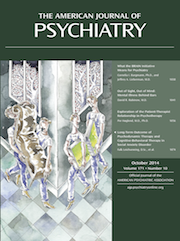Major depressive disorder is a recurrent condition affecting approximately 2% of children and 8% of adolescents (
1,
2). Untreated, this disorder has a significant impact on psychosocial functioning and increases the risk for suicidality and the development of other disorders, such as substance abuse (
2). Pediatric acute randomized controlled studies have shown response rates of 40%–60% to psychosocial and pharmacological treatments (
2,
3). Remission rates, however, even for the combination of psychosocial and pharmacological treatments, are relatively low (30%–40%), indicating that a substantial proportion of youths remain symptomatic (
2–
5). The presence of residual depressive symptoms has been associated with a worse course and a higher risk of relapse or recurrence of major depressive episodes. Thus, more efficacious treatments are needed that target acute symptoms of depression and increase the rates of remission.
Different strategies have been used to diminish the residual depressive symptoms that persist after acute treatment (in order to achieve full remission) and to prevent relapse and recurrence. These strategies include, among others, optimizing the dosage and duration of antidepressant treatment and combining antidepressants with other medications or with psychosocial treatments (
2,
6–
8). Even using these strategies, residual depressive symptoms often persist and relapse rates remain high. In this issue, Kennard et al. (
9) report on a study evaluating whether a sequential treatment model would improve relapse and remission measures in youths. Kennard et al. openly treated 200 adolescents with major depression (a mean score of 58.3 on the Children’s Depression Rating Scale–Revised [CDRS-R]) with flexible dosing of fluoxetine (mean dosage, 32.5 mg/day) for 6 weeks. Subsequently, 144 patients (72%) who exhibited treatment response—defined as a reduction of 50% or more on CDRS-R score—were randomly assigned to receive 6 months of continuation treatment either with fluoxetine (N=69) or with fluoxetine plus relapse-prevention cognitive-behavioral therapy (CBT) (N=75). Rates and timing of remission and relapse, as well as the percentage of time euthymic during follow-up, were evaluated by independent interviewers. One of the main goals of the study was to decrease residual depressive symptoms. Although no significant between-group differences in the rates and times to remission were observed, the authors found that among those who remitted, the combination treatment was associated with lower relapse rates at different time points (e.g., by 30 weeks: 9% compared with 26.5%). The time to relapse was also significantly lengthened (28.8 weeks compared with 27.0 weeks), the clinical relevance of which is unclear. Youths who received the combination treatment also had significantly more time euthymic during the follow-up period than those who received fluoxetine monotherapy (55.9% compared with 46.2%).
This study adds to the literature that demonstrates the beneficial role of CBT in the prevention, acute and continuation treatment, and management of treatment-resistant depression in youths with major depression (
2,
10–
17). The results should be considered in light of potential limitations. Naturalistic longitudinal studies and open-treatment longitudinal studies after acute randomized trials have shown that the symptoms of depression continue to improve, independently of treatment assignment (
4,
18,
19). In this study we do not know whether the rates of remission and relapse resulted specifically from the treatments, or whether the observed results were in part due to the natural course of illness, thus highlighting the value of including another control group (e.g., placebo or treatment as usual) (
8). The importance of this issue is exemplified by a recent study in adolescents with bipolar disorder showing that family-focused therapy plus pharmacotherapy neither accelerated recovery nor delayed recurrences to a greater extent than brief psychotherapy plus pharmacotherapy (
20). Second, despite the use of independent interviewers in the Kennard et al. study, the youths and their parents were not blind to treatment assignment. Again, including a control group could have helped to evaluate the presence of any possible biases. Third, open treatment with fluoxetine was limited to 6 weeks. Although the response during the acute treatment was about 70%, 6 weeks of acute pharmacological treatment does not reflect regular clinical practice, and longer courses of treatment could be associated with higher rates of remission.
Despite the evidence in its favor, CBT remains underutilized, even for depression that has not responded to antidepressant monotherapy. The reasons for this are not clear, but they may include lack of awareness of CBT’s benefits, unavailability of trained CBT clinicians, the cost and time requirements for CBT training, limited insurance coverage for psychotherapy, and patient or family resistance to participating in therapy. Also, as Kennard et al. mention, it is possible that symptoms of depression, particularly lack of motivation and irritability, may interfere with the patient’s cooperation with CBT, which requires active participation of patients and their families. Thus, perhaps for certain cases, the most efficacious treatment plan provides initial open treatment with an antidepressant to ameliorate the depressive symptoms, followed by CBT to consolidate the response and diminish the risk of relapse. However, one must consider that youths who have already responded to antidepressants may not be interested in starting psychotherapy after they are already improving.
Given the benefits of CBT for the management of major depression in youths, it is important to study the barriers associated with its use and dissemination across clinical settings (
11,
12). Also, since exposure to ongoing stressors (e.g., abuse, family conflicts, bullying), the presence of comorbid disorders (e.g., anxiety, attention deficit hyperactivity disorder, substance abuse), and poor adherence to treatment negatively influence the course and outcome of major depression (
2,
6,
12,
19,
21), other psychosocial treatments in addition to CBT (
11) may be indicated, and their study is warranted. In the meantime, Kennard et al. have demonstrated the importance of adding CBT to ongoing pharmacological treatment to prevent relapse in youths with major depression.

